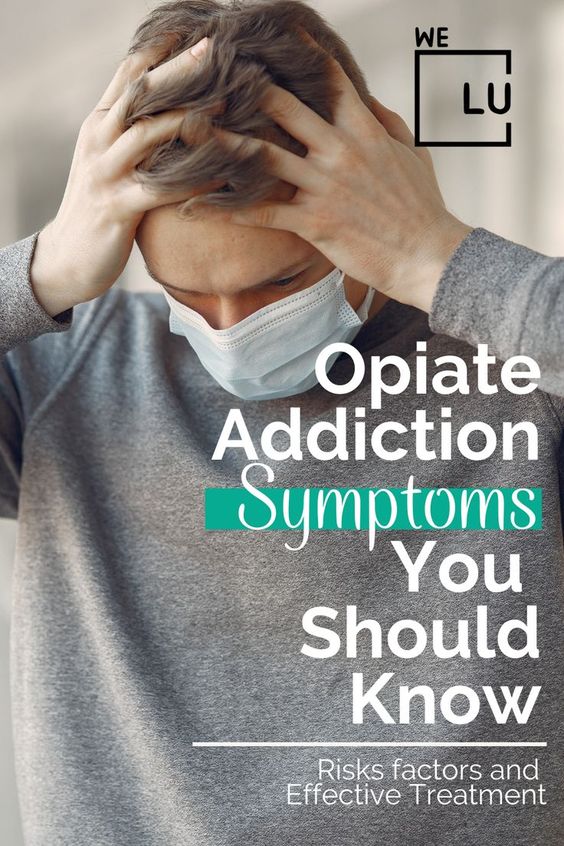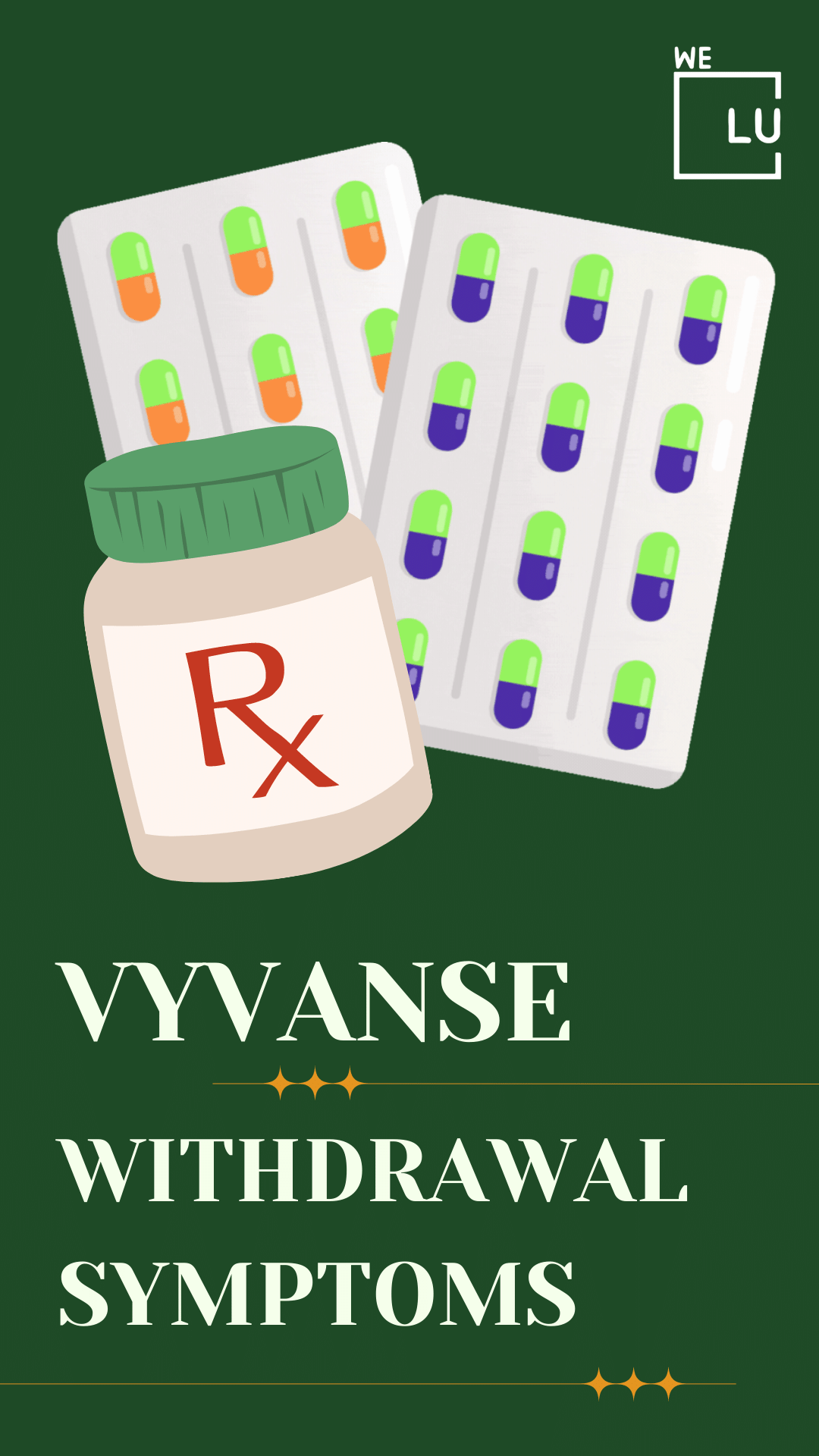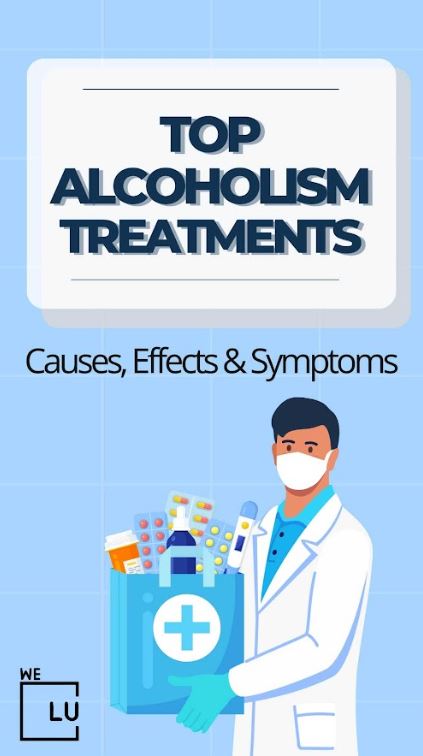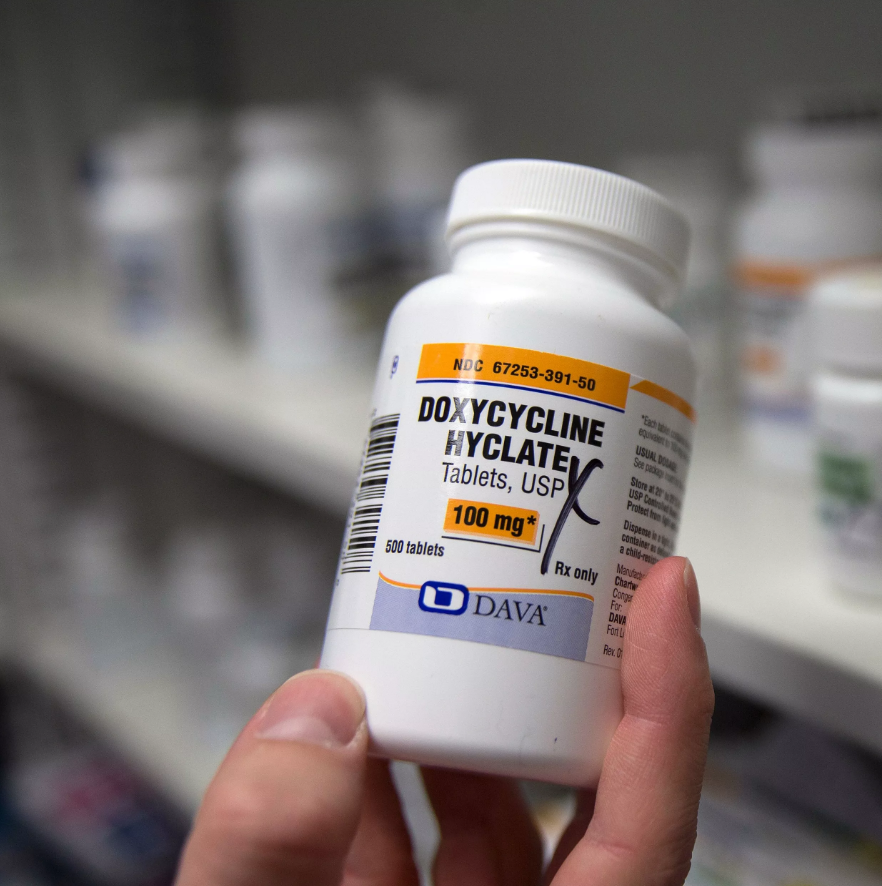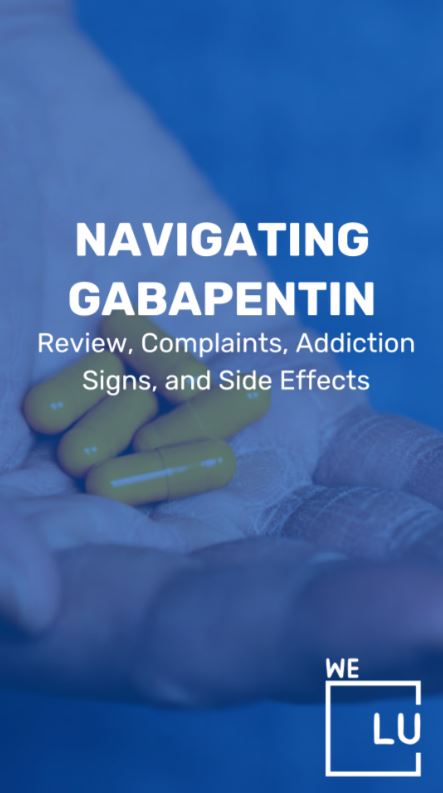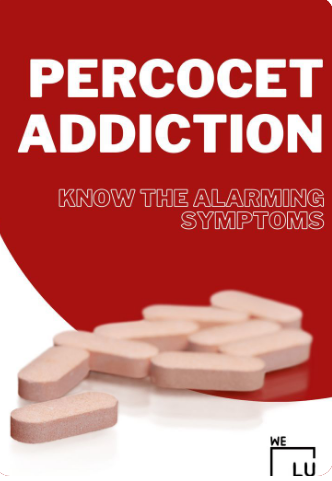Psychoactive Drugs Overview
Psychoactive drugs affect the brain and cause changes in awareness, mood, thoughts, feelings, or behavior. Psychoactive drugs target the central nervous system (CNS), altering regular activity. Examples of psychoactive drugs and substances include alcohol, caffeine, nicotine, marijuana, and certain pain medicines. Also, many illegal drugs, such as heroin, LSD, cocaine, and meth, are psychoactive.
Psychoactive Drugs Definition
When we hear the term “psychoactive drugs,” we often think of illegal substances like LSD, heroin, and cocaine. But did you know that there’s a whole world of psychoactive substances that are legal? From nicotine to alcohol to caffeine, these everyday substances profoundly impact our minds. A whopping 80% of adults in America rely on caffeine every day.
According to the US National Institute of Health (NIH), psychoactive drugs are also called psychotropic substances. When ingested or administered (injected, snorted, inhaled), these mind-altering compounds can alter a person’s mental state, emotions, and behavior, changing the brain’s response to stimuli. Changes include:
- Mood changes.
- Altered thoughts.
- Behavioral shifts.
- Heightened awareness.
- Even changes in how you feel.
Curious to learn more about the various types of psychoactive drugs and their effects? You’ve come to the right place. Dive into this topic and explore the psychoactive drug’s effects, risks, and uses.
Looking for help with psychoactive drug dependence? Join thousands of clients who trust We Level Up New Jersey for substance abuse treatment. Call 24/7 for more psychoactive drug detox information today. Your call is free and confidential. Access addiction professionals who understand your circumstances and are ready to help.
What are Psychoactive Drugs?
The effects of all psychoactive drugs occur through their interactions with our endogenous neurotransmitter systems. Most people associate a“psychoactive” drug with illicit or controlled substances. However, a substance doesn’t necessarily have to be addictive to be considered psychoactive.
All it needs to do is act on the brain and transform how someone thinks, behaves, or perceives the world around them. And some drugs pose more dangers than others.
Top 6 Types of Psychoactive Drugs
Many legal and illegal substances contain psychoactive properties, so knowing the benefits and risks of these psychoactive drugs is essential. There are several types of psychoactive drugs, but these are the top 6.
Common psychoactive drugs examples and types:
- Depressants. Including alcohol, benzodiazepines, and barbiturates, which slow down the central nervous system.
- Opioids. Like heroin, morphine, and prescription painkillers relieve pain and induce euphoria.
- Stimulants. Such as caffeine, amphetamines, and cocaine, which increase alertness and energy.
- Hallucinogens. Such as LSD and psilocybin mushrooms, which alter perception and produce hallucinations.
- Designer drugs. Designer drugs, like MDMA (Ecstasy), synthetic cannabinoids (Spice or K2), and bath salts (Flakka), are chemically engineered substances created to mimic the effects of controlled substances while evading legal restrictions.
- Cannabinoids. For example, THC in marijuana can produce altered perception and mood changes.
Go on to learn more about these psychoactive drugs.
Psychoactive Effects of Drugs
According to the Substance Abuse and Mental Health Service Administration (SAMHSA), 16.9 million Americans misused prescription psychotherapeutic or psychoactive drugs at least once in 2017. This number of prescription psychoactive drug misusers corresponds to the US 6.2 percent of the population.
Psychoactive Drugs Effects
- Altered perception.
- Mood changes.
- Euphoria.
- Increased alertness.
- Relaxation.
- Hallucinations.
- Sedation.
- Impaired coordination.
- Reduced pain perception.
- Dependence and addiction.
The most dangerous and potent psychoactive drugs are the ones that usually need the intervention of professional help when they lead to dependence or addiction. Physical dependence involves changes in normal bodily functions—the person will experience withdrawal from the psychoactive drugs upon discontinuance of use. In contrast, someone with a psychological dependency has an emotional, rather than physical, need for psychoactive drugs and may use the drug to relieve psychological distress.
Tolerance is associated with physiological dependence, which happens when someone requires more and more psychoactive drugs to achieve effects previously experienced at lower doses. Tolerance can cause someone to increase the number of drugs used to a critical level—even to the point of overdose and death. If this describes you or someone you love, seek professional help.
We Level Up NJ specializes in treating psychoactive drug addiction and dependence. Contact us today for more treatment options, and continue to read to learn more.
Risks of Mind Altering Substances
Most psychoactive drugs, especially prescriptions, should only be used under medical supervision. Controlled substances outside medical use are prohibited and can lead to legal consequences. Here are the following risks of using psychoactive drugs:
- Health Risks: Psychoactive drugs can lead to various physical and mental health problems, including addiction, respiratory issues, cardiovascular problems, liver damage, and mental disorders.
- Impaired Judgment: These substances can impair decision-making, leading to risky behaviors such as unsafe sex, accidents, and dangerous confrontations.
- Legal Consequences: Possession and use of many psychoactive drugs are illegal in many jurisdictions, resulting in potential legal troubles, fines, and imprisonment.
- Dependence and Withdrawal: Regular use can lead to physical and psychological dependence, with withdrawal symptoms upon discontinuation.
- Mental Health Effects: These substances can exacerbate or trigger mental health conditions like anxiety, depression, and psychosis.
- Overdose: Overconsumption can lead to life-threatening overdose situations.
- Impaired Functioning: They can hinder daily functioning, impacting relationships, work, and overall quality of life.
- Accidents and Injuries: Impaired coordination and judgment can lead to accidents and injuries.
- Financial Consequences: Substance use can lead to financial strain due to the cost of acquiring substances and dealing with legal and health-related expenses.
- Social Isolation: Excessive use can lead to isolation, as individuals may prioritize substance use over social connections.
If you notice these signs of psychoactive risks, contact an accredited treatment center for substance abuse. We Level Up New Jersey rehab stands by, ready to help.
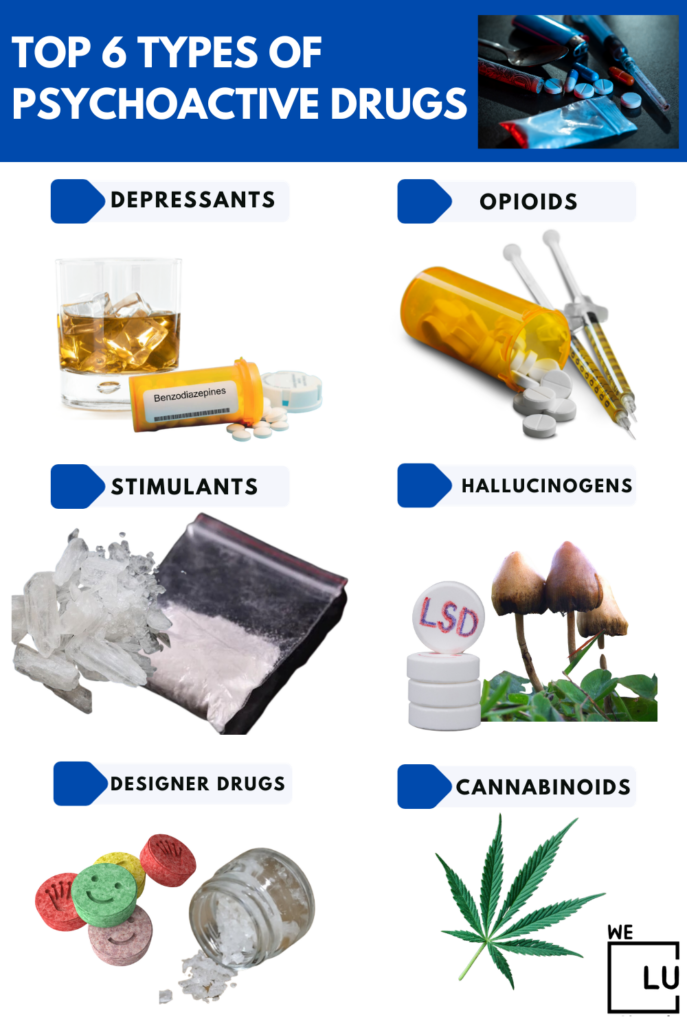
Types of Psychoactive Drugs
Depressants
Depressants slow down the activity in the central nervous system (brain and spinal cord). They typically cause people to feel relaxed and sedated. Depressants reduce the person’s alertness and slow down heart rate and breathing functions. Some people take prescribed depressants to help with anxiety or sleep. Others abuse these substances to get high.
- Sedative hypnotics include medications like Ambien and Lunesta.
- Benzodiazepines include medications like Valium, Xanax, and Klonopin.
- Barbiturates include medications like Nembutal (Pentobarbital) and Luminal.
Is alcohol a depressant? The answer is yes. You may feel happier and calmer when you first drink, but excess alcohol can cause slurring and processing problems. It can make your feelings of anxiety and depression worse.
Depressants inhibit the central nervous system (CNS), increasing the activation of the gamma-aminobutyric acid (GABA) neurotransmitter. This increased activity reduces brain function, resulting in the relaxing effect of these drugs. Other symptoms of taking depressants include:
- Slow brain function.
- Poor concentration.
- Confusion.
- Dizziness.
- Slurred speech.
- Visual disturbances.
- Lack of coordination.
- Depression.
- Addiction.

Skip To:
Learn More:
- Alcohol Induced Psychosis
- Is Cocaine a Stimulant or Depressant? What Type of Drug is Cocaine?
- Effective Opioid Addiction Treatment Options, Signs, Symptoms, Risks & Help
- Illegal Stimulants Addiction
- Hallucinogens Types and Effects
- Guide to Devastating Zombie Drugs. New Zombie Drug 2023 DEA Warnings & Dangers. Tranq Zombie Drug vs Flakka vs Xylazine vs Krokodil Flesh-Eating Zombie Drug Photos.
- THC Withdrawal, Coping With Cannabis Withdrawal Symptoms
- Benzodiazepine Detox, Withdrawal, Symptoms, Timeline, & Treatment
- Barbiturate Overdose Guide. Barbiturate Overdose Meaning. Barbiturate Overdose Effects, Symptoms, Dangers & Addiction Treatment.
- Prescription Drug Addiction, Types, Symptoms, & Causes
Opioids
Opioids also act as depressants. When used as prescribed, opioids can help someone with moderate or severe pain. When abused, they can produce feelings of relaxation and euphoria.
Opioids include drugs like:
- Heroin.
- Fentanyl.
- Vicodin.
- Morphine.
- Oxycodone.
The strength of each opioid varies, so it’s not always evident how much you’re taking. And if you get pills off the street, you never know exactly what you’re getting. For instance, you may assume you’re getting Vicodin, but a dealer may lace the pill with fentanyl, which is highly addictive and deadly.
If you stop using opioids abruptly, you may undergo withdrawal symptoms. These withdrawal symptoms range in severity. You could feel sick for several days before your body starts to heal. During that time, you’re at risk of relapsing. That’s because you may experience increased cravings. Most people benefit from a medically assisted detox throughout this stage and then professional opioid addiction treatment once the drugs are out of their system.
Opioids Effect on the Brain
Opioids have become a national epidemic. According to the National Institute on Drug Abuse (NIDA), in 2019, nearly 50,000 people in the United States died from opioid-involved overdoses. The misuse of and addiction to opioids—including heroin, prescription pain relievers, and synthetic opioids such as fentanyl—is a severe national crisis that affects public health and social and economic welfare.
Opioids bind to specific receptors in the spinal cord, brain, and gastrointestinal tract. In doing so, they reduce the body’s perception of pain. However, opioids can also impact other body systems, such as slowing breathing, altering mood, and causing constipation. Opioid receptor binding causes the signs and symptoms of overdose and the euphoric effects or “high” with opioid use.
Opioids are particularly addictive because long-term consumption changes the way nerve cells work in the brain, even when a person is taking them as prescribed to treat pain.
Get addiction counseling that works. Discover professional help from We Level Up NJ’s addiction and mental health therapists. Start getting support with a free call to our addiction hotline.
Stimulants
Stimulants increase the activity of the central nervous system, making the person more alert and aroused. Examples of stimulants are nicotine, caffeine, cocaine, ecstasy and methamphetamines, speed drugs, and ice.
Stimulants increase brain activity. As a result, it enhances energy and alertness. Some individuals have been prescribed stimulants for symptoms related to narcolepsy (sleep disorder) and ADHD.
Common stimulants include:
- Amphetamine.
- Cocaine.
- Adderall.
- Speed drug.
When stimulants are abused, they can produce a euphoric rush, but a “crash” soon follows, making the person want to continue taking more drugs.
Long-term abuse can result in several health complications, including:
- Stroke.
- Heart attacks.
- Tissue damage.
Heavy stimulant users may develop withdrawal symptoms after stopping drug use.
Common symptoms can include:
- Insomnia.
- Depression.
- Anxiety.
Stimulants Effect on the Brain
Like all drugs that may lead to abuse and addiction, stimulants affect the limbic reward system of the brain. Stimulants increase the release of dopamine, a neurotransmitter in the brain that regulates the feelings of pleasure and alters the control of movement, motivation, cognition, and euphoria.
When there are high dopamine levels, a person will feel their mood enhanced (feelings of euphoria) and increased motor activity. However, when dopamine surges, people may become nervous, aggressive, irritable, or paranoid. Other effects of stimulants include hallucinations, bizarre thoughts, and paranoia that approach schizophrenia. Like depressants, stimulants can increase tolerance, dependence, and addiction.
Get Help. Get Better. Get Your Life Back.
Searching for Accredited Drug & Alcohol Rehab Centers Near You? Or Mental Health Support?
Even if you have failed previously, relapsed, or are in a difficult crisis, we stand ready to support you. Our trusted behavioral health specialists will not give up on you. Call us when you feel ready or want someone to speak to about therapy alternatives to change your life. Even if we cannot assist you, we will lead you wherever you can get support. There is no obligation. Call our hotline today.
FREE Addiction Hotline – Call 24/7Hallucinogens
Hallucinogens include several drugs that alter your consciousness. It makes someone hear, smell, or feel things that aren’t there. Classic hallucinogens (psychedelics) interfere with specific serotonin-receptor activities and produce hallucinations. Substances in these groups imitate the effects of traditional drugs such as 2C-B, LSD, and DMT but may also possess residual stimulant activity.

Hallucinogens disrupt the connection between brain chemical systems. When abused by the body, hallucinogens can result in sensory issues, mood problems, and sleep disruptions. They can also trigger delusions and hallucinations. Sometimes, individuals experience a “bad trip.” When this happens, they may feel stuck in a panicked state for hours or days. Eventually, they may experience flashbacks syndromes, where they relive the panic repeatedly.
Hallucinogens include drugs like:
- LSD.
- Psilocybin.
- DMT.
- Peyote.
- Ketamine.
- Magic mushrooms.
- Cannabis.
- DXM.
Hallucinogens Effect on the Brain
Hallucinogens primarily affect the neural circuits in the brain that produce serotonin (a neurotransmitter) and have perception-altering effects on the user. These experiences are unpredictable and vary from person to person. While these drugs do not produce the physical symptoms of addiction and withdrawal that opioids, depressants, and stimulants cause, they significantly alter brain functions.
Long-term effects of hallucinogens include paranoia, persistent visual disturbances (flashbacks), disorganized thinking, and mood disturbances. Flashbacks (formally termed Hallucinogen Persisting Perception Disorder) produce intense hallucinations that are nearly impossible to predict.
Cannabinoids
Cannabinoids, such as tetrahydrocannabinol (THC) found in marijuana, primarily affect the brain’s endocannabinoid system, crucial in regulating various physiological processes. When cannabinoids interact with this system, they can produce a range of effects on the brain, including:
- Altered Perception: Cannabinoids can lead to changes in perception, including alterations in sensory perception, time perception, and spatial awareness.
- Euphoria: THC, in particular, can induce euphoria or a “high,” a state of elevated mood and relaxation.
- Impaired Memory: Short-term memory and cognitive functions may be temporarily impaired under the influence of cannabinoids.
- Altered Thinking: Cannabinoids can lead to altered thought patterns and can influence creativity and problem-solving abilities in some individuals.
- Increased Appetite: The “munchies” phenomenon is often associated with cannabinoid use, as it can stimulate appetite.
- Relaxation: Many users feel relaxed and reduced stress or anxiety when using cannabinoids.
- Altered Motor Skills: Coordination and motor skills may be affected, leading to impaired driving ability and an increased risk of accidents.
- Anxiety and Paranoia: While some users experience reduced stress, others may experience heightened anxiety or paranoia, especially with high doses or in individuals prone to anxiety disorders.
- Psychosis: In some cases, especially with high THC doses, cannabinoids can induce psychotic symptoms like hallucinations, delusions, and disorganized thinking.
The effects of cannabinoids can vary widely from person to person and depend on factors such as the type of cannabinoid, dose, method of consumption, and individual sensitivity. Long-term or heavy use of cannabinoids can also have more lasting effects on the brain, including the potential for addiction and cognitive impairments. However, the extent of these effects is still an active area of research.
Designer Drugs
Designer drugs have been formulated to imitate the effects of illegal substances while still trying to be sold legally. They are often produced in homes or secret illicit labs. They can be made from plant substances or entirely synthetic chemicals that can be legally purchased to attempt to create a new “legal” substance. There are many different kinds of designer drugs.
Common ones include:
- Bath salts.
- Spice/K2 (synthetic marijuana).
- Krokodil.
- MDMA/Ecstasy/Molly.
- MXE.
- Flakka.
- W18.
These drugs are synthesized. That means they are artificial. Their chemical composition remains unknown. Because of that, it’s impossible to know what you’re taking when you take a designer drug. Often, manufacturers use many different chemicals to create these drugs.
Designer Drugs Effect on the Brain
Designer drugs are dangerous because the combinations used to create them are untested. As a result, designer drugs’ effects on the body are often unknown, as are the effects on the brain and the user’s overall health and behavior. Moreover, because drugs are created so quickly with chemicals not meant for human consumption, there is little known about the long-term health effects for users.
Examples of Psychoactive Drugs Chart
| Types of Psychoactive Drugs | List of Psychoactive Drugs | Psychoactive Drugs Effects |
|---|---|---|
| Stimulants | Caffeine | Increased alertness and energy |
| Amphetamines | Euphoria, increased alertness | |
| Cocaine | Euphoria, increased alertness | |
| Depressants | Alcohol | Relaxation, impaired coordination |
| Benzodiazepines | Sedation, relaxation | |
| Barbiturates | Sedation, relaxation | |
| Hallucinogens | LSD (Lysergic acid) | Hallucinations, altered perception |
| Psilocybin (Mushrooms) | Hallucinations, altered perception | |
| Opioids | Heroin | Euphoria, pain relief |
| Morphine | Pain relief, sedation | |
| Prescription Painkillers | Pain relief, potential addiction | |
| Cannabinoids | THC (found in marijuana) | Altered perception, relaxation |
Dangers of Psychoactive Substance Abuse
Psychoactive drugs that lead to addiction are a complex problem to address. In most instances, ending addiction on your own is unsafe. Most people find they need the help and support of medical and counseling professionals in rehab treatment facilities like the We Level Up drug addiction centers.
Prolonged use of psychoactive drugs can cause brain damage. Read on to uncover how psychoactively affects the brain.
Top 10 Most Frequently Asked Questions About What is a Psychoactive Drug?
-
What is a psychoactive substance?
A psychoactive substance is a chemical compound that alters an individual’s mental state, leading to changes in perception, mood, consciousness, or behavior when consumed or ingested. These substances can include drugs, medications, or natural compounds that affect the central nervous system and have the potential to produce various psychological and physiological effects.
-
Why do psychoactive drugs make people feel good?
Psychoactive drugs often make people feel good by interacting with the brain’s neurotransmitter systems, such as dopamine, serotonin, and endorphins, which play crucial roles in regulating mood and pleasure. These drugs can either mimic the effects of these neurotransmitters or enhance their activity, leading to euphoria, relaxation, or a sense of well-being, depending on the specific drug and its mechanism of action.
-
Is alcohol psychoactive?
Yes, alcohol is considered a psychoactive substance. It has a depressant effect on the central nervous system, leading to altered mental states, changes in mood, impaired judgment, and various physiological effects, including relaxation and sedation, which can make people feel differently when consumed.
-
Which psychoactive drugs slow down mental and physical activity?
Psychoactive drugs that slow down mental and physical activity are known as depressants or sedatives. These substances, such as alcohol, benzodiazepines, and barbiturates, act on the central nervous system to reduce neural activity, resulting in relaxation, decreased anxiety, and a general sense of calm, often leading to slowed mental and physical processes.
-
Which are the main categories of psychoactive drugs?
The main categories of psychoactive drugs include stimulants, depressants, hallucinogens, and opioids. Stimulants, like caffeine and amphetamines, increase alertness and energy levels. Depressants, such as alcohol and sedative medications, slow down the central nervous system. Hallucinogens, like LSD and psilocybin, alter perception and consciousness, often causing hallucinations. Opioids, including drugs like heroin and prescription painkillers, are known for their pain-relieving properties and potential for addiction. Each category has distinct effects on the mind and body.
-
How do psychoactive drugs affect the brain?
Psychoactive drugs affect the brain by interacting with neurotransmitter systems and receptors. They can either mimic or inhibit the activity of neurotransmitters like dopamine, serotonin, or gamma-aminobutyric acid (GABA), leading to changes in mood, perception, and behavior. These alterations in neurotransmitter function can result in various psychological and physiological effects, depending on the specific drug and its mechanism of action.
-
Is caffeine a psychoactive drug?
Yes, caffeine is considered a psychoactive drug. It stimulates the central nervous system, leading to increased alertness and reduced feelings of fatigue, and it can also affect mood and concentration.
-
Is nicotine a psychoactive drug?
Yes, nicotine is a psychoactive drug. It is a stimulant that affects the central nervous system, leading to increased alertness, improved concentration, and a sense of relaxation for some individuals. However, nicotine is highly addictive and has various health risks, mainly when consumed through tobacco products like cigarettes.
-
Which is responsible for the effects of psychoactive drugs?
The effects of psychoactive drugs are primarily driven by their ability to alter the functioning of neurotransmitter systems in the brain. These drugs can either enhance or inhibit the activity of specific neurotransmitters, such as dopamine, serotonin, or GABA, leading to changes in mood, perception, cognition, and behavior.
-
The four primary classes of psychoactive drugs are __.
The four primary classes of psychoactive drugs are stimulants, depressants, hallucinogens, and opioids. Stimulants increase alertness and energy levels, depressants slow down the central nervous system, hallucinogens alter perception and consciousness, and opioids are known for their pain-relieving properties and potential for addiction. Each class has distinct effects on the mind and body.
Psychoactive Drugs Facts
Are Psychoactive Drugs Medication?
A chemical compound known as a psychoactive drug, psychopharmaceutical, psychoactive agent, or psychotropic drug alters nervous system functioning and affects perception, emotion, consciousness, cognition, or behavior. Many are prescription drugs, but some are also illicitly produced.
The Effect of Psychoactive Drugs
Any medication that alters behavior, emotions, thoughts, or perception is called a psychotropic. It is a catch-all for many drugs, including illicit and prescribed medications.
Psychoactive Drugs Action
Drugs that briefly alter neurochemistry do so to temporarily change a person’s mood, cognition, perception, and behavior. Psychoactive substances have a variety of effects on the brain.
Psychoactive drugs affect behavior and perception through:
- Their interactions with the central nervous system primarily influence neurotransmitter systems and receptors in the brain. These interactions can lead to changes in mood, cognition, and physical sensations, ultimately altering an individual’s behavior and perception of reality.
- The specific mechanisms by which these drugs exert their effects vary depending on the drug and its classification, whether it’s a stimulant, depressant, hallucinogen, or opioid. Still, they all target the neural processes that underlie behavior and perception.
Almost all psychoactive drugs affect mood and behavior by altering the functioning of neurotransmitter systems and receptors in the brain. Psychoactive drugs act on the nervous system to modulate neurotransmitter activity, influencing an individual’s mental state, behavior, and perception.
Psychoactive drugs are substances that:
- Alter Mental Processes: These drugs can change cognitive functions, including perception, memory, and attention.
- Influence Behavior: They can lead to changes in a person’s actions and conduct, often by modifying decision-making and inhibitions.
- Affect Mood: Psychoactive drugs have the potential to induce various emotional states, ranging from euphoria to depression or anxiety.
- Modify Consciousness: They can alter an individual’s state of awareness, often leading to shifts in consciousness, including altered states or hallucinations.
- Impact Physical Sensations: Some psychoactive drugs can affect physical sensations and bodily experiences.
- Interact with Neurotransmitters: They work by interacting with neurotransmitter systems and receptors in the brain, which regulate communication between nerve cells.
- Have Potential Side Effects: Psychoactive drugs may lead to a range of side effects, both positive and negative, depending on the specific drug and its use.
- Can Be Legal or Illegal: These substances can include prescription medications, over-the-counter drugs, recreational drugs, and illicit substances.
- Vary in Mechanism of Action: They can act as stimulants, depressants, hallucinogens, or opioids, each with distinct effects on the central nervous system.
- Carry Risks and Benefits: Psychoactive drugs can offer therapeutic benefits when used appropriately under medical supervision, but they also carry the risk of addiction, misuse, and adverse health consequences when abused.
Psychoactive Drugs Psychology Definition
Psychoactive drugs in psychology refer to substances that alter an individual’s mental processes, behavior, mood, or consciousness by affecting neurotransmitter systems and receptors in the brain.
Psychoactive Drugs Side Effects
Among the risks associated with psychoactive substances are:
- Higher blood pressure, a quick heartbeat, difficulty sleeping or eating, nausea and vomiting, shakiness, or dizziness are a few short-term physical symptoms.
- Long-term consequences include cardiovascular disease, breathing problems, and kidney or liver damage.
Psychoactive drugs impact the central nervous system, leading to changes in an individual’s mental state, behavior, mood, and perception. The drugs that slow down mental and physical activity are called depressants. Other types of psychoactive drugs are stimulants and hallucinogens.
The side effects of psychoactive drugs can vary widely depending on the specific drug, dosage, individual factors, and how they interact with the person’s physiology. Some common side effects of psychoactive drugs may include:
- Nausea and Vomiting: Many drugs can cause gastrointestinal distress, leading to nausea and vomiting.
- Dizziness and Impaired Coordination: Some psychoactive drugs, especially depressants, can result in dizziness, impaired motor skills, and poor coordination.
- Changes in Mood: While psychoactive drugs may initially induce euphoria or relaxation, they can also lead to mood swings, anxiety, irritability, or depression.
- Addiction and Withdrawal: Many psychoactive drugs have a high potential for addiction, and their abrupt cessation can result in withdrawal symptoms such as cravings, anxiety, and physical discomfort.
- Cognitive Impairment: Some drugs can impair cognitive function, including memory, attention, and decision-making.
- Physical Health Effects: Long-term use of certain psychoactive drugs can harm physical health, such as liver damage, heart problems, or respiratory issues.
- Psychological Effects: Hallucinogenic drugs may lead to disturbing or traumatic experiences, known as “bad trips,” which can have lasting psychological effects.
- Overdose: Taking excessive amounts of certain psychoactive drugs, such as opioids or stimulants, can lead to overdose, which can be life-threatening and have serious health consequences.
Specific side effects can vary widely depending on the drug’s category (stimulant, depressant, hallucinogen, opioid), individual differences, and how the drug is used. Always consult with a healthcare professional and follow prescribed guidelines when using psychoactive medications to minimize the risk of adverse effects.
Is Caffeine a Psychoactive Drug?
Caffeine is a psychoactive (mind-altering) substance that impacts our emotions and thoughts. It is a stimulant that quickens our heart rate, respiration, thinking, and behaviors. Some shrubs’ seeds, leaves, and fruit, including coffee and tea plants, contain caffeine. Moreover, it can be created in a lab.

Get Your Life Back
Find Hope & Recovery. Get Safe Comfortable Detox, Addiction Rehab & Mental Health Dual Diagnosis High-Quality Care at the We Level Up Treatment Centers Network.
Hotline (877) 378-4154Psychoactive Drug Statistics
There was a growing recognition of the link between mental health disorders and psychoactive drug abuse. Co-occurring conditions were common, and there was a push for integrated treatment.
The abuse of prescription medications, especially opioids and benzodiazepines, remained a significant issue. Many individuals were misusing these drugs, leading to addiction and overdose cases.
70,000
In 2019, there were over 70,000 drug overdose deaths, with opioids contributing to most of these fatalities. Opioid overdoses were a significant US public health concern.
Source: NIDA
1.9 Million
During the same year, an estimated 1.9 million people aged 12 or older had used methamphetamine in the past year.
Source: NSDUH
43.5 Million
Another survey data from 2019 showed that approximately 43.5 million people aged 12 or older had used marijuana in the past year.
Source: NSDUH
Dangers of Psychoactive Drugs
All drugs cause a reaction within your body. Some responses are positive and expected; others cause significant and long-lasting complications. Those complications and difficulties are increased when the drugs are abused. Some of the dangers of psychoactive drugs include:
- Short-term physical effects include rapid heartbeat, higher blood pressure, problems with eating and sleeping, vomiting and nausea, shakiness, or dizziness.
- Long-term effects such as respiratory difficulties, cardiovascular illness, kidney or liver damage
- Physical dependence, which involves a change of brain chemistry, leading to poor judgment and uncharacteristic risk-taking, as well as financial problems
- Cognitive difficulties regarding the ability to think clearly and make informed decisions.
The most severe effects are tied to more dangerous drugs such as heroin, fentanyl, and cocaine or legal drugs such as alcohol. But even psychoactive drugs that are widely found in foods, such as caffeine, can also cause problems with dependence.
Before taking psychoactive drugs, individuals should consider several important factors:
- Consultation with a Healthcare Professional: Seek guidance from a qualified healthcare provider who can assess your medical history, current health condition, and any potential contraindications or interactions with other medications.
- Prescription Requirements: If the drug requires a prescription, obtain it legally and only from a licensed healthcare provider.
- Dosage and Usage Instructions: Follow the dosage and usage instructions carefully to avoid misuse or overdose.
- Potential Side Effects: Be aware of the possible side effects associated with the drug and monitor for any adverse reactions.
- Interactions: Understand how the drug may interact with other substances, including alcohol, medications, or recreational drugs.
- Addiction Potential: Recognize the risk of addiction or dependence that some psychoactive drugs carry and use them as directed.
- Tolerance and Withdrawal: Be aware of the potential for developing tolerance (needing higher doses for the same effect) and withdrawal symptoms when discontinuing certain psychoactive drugs.
- Mental Health Considerations: Consider any preexisting mental health conditions, as some psychoactive drugs can exacerbate or interact with these conditions.
- Long-Term Effects: Consider the potential long-term effects of the drug and weigh the benefits against the risks.
- Legal Status: Ensure the drug is obtained and used in compliance with local and national laws and regulations.
- Environment: Evaluate the setting and circumstances in which you plan to use the drug, as it can influence the overall experience and safety.
- Support System: Have a support system, such as friends, family, or healthcare professionals, who can assist if any issues or emergencies arise.
- Alternative Treatments: Explore alternative treatments or therapies that may address your needs without using psychoactive drugs, especially if the medication is not medically necessary.
It’s crucial to make informed decisions about psychoactive drug use and prioritize safety and responsible usage. Always consult a healthcare professional when in doubt, and never hesitate to seek help or guidance if you encounter any difficulties or concerns while using these substances.
Psychoactive Drugs Withdrawal Symptoms
If someone uses psychoactive drugs regularly and stops, the person is likely to experience withdrawal. Withdrawal can cause symptoms that could last for several weeks or even months.
Common withdrawal symptoms:
- Vomiting.
- Restlessness.
- Irritability.
- Agitation.
- Sleep problems.
- Low mood.
- Diarrhea.
- Heavy sweating.
- Anxiety.
- Headaches.
- Low energy.
- Poor concentration.
- Mood swings.
- Aches and pains.
- Nausea.
- Low appetite.
- Craving drugs.
More extreme withdrawal symptoms:
- Extreme panic and anxiety.
- Anger.
- Depression.
- Hallucinations.
- Paranoia.
- Racing heart.
- Aggression and violence.
- Suicidal thoughts.
- Ongoing diarrhea and vomiting.
- Confusion and memory problems.
These withdrawal symptoms can be very distressing and risky for people to manage alone. However, drug abuse treatment can help people manage these symptoms.
First-class Facilities & Amenities
World-class High-Quality Addiction & Mental Health Rehabilitation Treatment
Rehab Centers TourRenowned Addiction Centers. Serene Private Facilities. Inpatient rehab programs vary.
Addiction Helpline (877) 378-4154Proven recovery success experience, backed by a Team w/ History of:
15+
Years of Unified Experience
100s
5-Star Reviews Across Our Centers
10K
Recovery Success Stories Across Our Network
- Low Patient to Therapist Ratio
- Onsite Medical Detox Center
- Comprehensive Dual-Diagnosis Treatment
- Complimentary Family & Alumni Programs
- Coaching, Recovery & Personal Development Events
Overcoming Psychoactive Drug Abuse. Find the Support You Need.
Withdrawal from psychoactive drugs is often challenging to go through alone. Many people experience relapses during withdrawal in an attempt to alleviate symptoms and satisfy cravings. Manage withdrawal symptoms to recover with professional detox and rehab therapy successfully. Find a robust support system at the We Level Up NJ treatment center. Contact us now. Your call is free and confidential.
Get a free rehab insurance check without any obligation.
Rehab Center for Psychoactive Drug Detox in New Jersey & Beyond
During your rehabilitation, the staff will help you identify what caused your substance abuse disorder and teach you skills that will help you change your behavior patterns and challenge the negative thoughts that led to psychoactive drug abuse.
If you or someone you love is struggling with psychoactive drug dependence and abuse, get them the safest help they need and deserve. Our team at We Level Up NJ specializes in creating an ideal environment and providing effective therapies to help individuals who struggle with drug abuse. We will develop a personalized addiction treatment plan and lead you to recovery. Get started today!
World-class, Accredited, 5-Star Reviewed, Effective Addiction & Mental Health Programs. Complete Behavioral Health Inpatient Rehab, Detox plus Co-occuring Disorders Therapy.
CALL (877) 378-4154End the Addiction Pain. End the Emotional Rollercoaster. Get Your Life Back. Start Drug, Alcohol & Dual Diagnosis Mental Health Treatment Now. Get Free No-obligation Guidance by Substance Abuse Specialists Who Understand Addiction & Mental Health Recovery & Know How to Help.
Top 20 Most Common Psychoactive Substance Dependence FAQs
-
Is ethanol a psychoactive drug?
People worldwide drink alcoholic beverages because they contain ethanol, a psychoactive substance that has calming and pleasurable effects. Alcohol, caffeine, nicotine, marijuana, and some painkillers are psychoactive. Numerous illegal chemicals, including heroin, LSD, cocaine, and amphetamines, are also psychoactive.
-
What are the positive effects of psychoactive drugs?
Positive effects of psychoactive drugs can vary widely depending on the specific drug and individual reactions. Still, some potential positive effects may include improved mood, increased alertness and focus, pain relief, enhanced creativity, and relaxation. For example, certain psychoactive drugs, when used responsibly and under medical supervision, can alleviate symptoms of anxiety or depression and improve overall well-being. However, these positive effects often come with potential risks and side effects, and misuse or addiction can lead to serious negative consequences.
-
Is CBD a psychoactive drug?
One of the principal substances in cannabis that is active is CBD. Although it is a psychoactive substance, it does not have the same intoxicating “high” as THC. At some dosages, CBD can reduce anxiety while promoting sleep.
-
How do psychoactive drugs affect the brain?
Serotonin, dopamine, and norepinephrine are the neurotransmitters the medication impacts in the brain. When the medication reaches the brain, these neurotransmitters are released from synaptic vesicles in neurons. As a result, neurotransmitter activity is boosted.
-
What do psychoactive drugs do?
A medication or drug that alters the way the brain functions and results in modifications to mood, consciousness, thoughts, feelings, or behavior. Alcohol, caffeine, nicotine, marijuana, and some painkillers are examples of psychoactive drugs.
-
What is the cactus psychoactive drug?
The hallucinogen mescaline is the primary component of peyote. Peyote has been part of indigenous peoples’ sacred rituals in northern Mexico and the southwestern United States since recorded history began. Peyote can be used to extract mescaline or be made synthetically.
-
The most widely used psychoactive drug in the world is?
The most widely used psychoactive drug in the world is caffeine. It is found in various beverages like coffee, tea, and soft drinks, as well as in some medications and supplements, and is known for its stimulant effects on alertness and energy.
-
Which of the following are psychoactive drugs?
The four primary classes of psychoactive drugs are stimulants, depressants, hallucinogens, and opioids. Stimulants increase alertness and energy levels, depressants slow down the central nervous system, hallucinogens alter perception and consciousness, and opioids are known for their pain-relieving properties and potential for addiction. Each class has distinct effects on the mind and body.
-
Psychoactive drugs have which type of effect on the body?
Psychoactive drugs have various effects on the body, primarily by altering the functioning of the central nervous system. These effects can include changes in mood, perception, cognition, and physical sensations. The specific impact of a psychoactive drug can vary widely depending on its classification (stimulant, depressant, hallucinogen, or opioid) and its mechanism of action within the brain and body.
-
What are the psychoactive drugs definition psychology?
In psychology, psychoactive drugs are defined as substances that can alter an individual’s mental processes, emotions, perception, or consciousness. These drugs can affect neural functioning by interacting with neurotransmitter systems, receptors, and brain chemistry. Psychologists study the psychological and behavioral effects of psychoactive drugs and their potential for addiction and therapeutic uses to understand better how they impact human cognition and behavior.
-
Is alcohol a psychoactive substance?
Yes, alcohol is considered a psychoactive substance. It can alter an individual’s mental state by depressing the central nervous system, leading to mood, cognition, and behavior changes. Alcohol’s psychoactive effects can include relaxation, reduced inhibitions, impaired judgment, and, in some cases, mood swings or aggression, depending on the amount consumed and the individual’s tolerance and susceptibility.
-
What is the famous journal of psychoactive drugs?
One of the well-known journals in psychoactive drugs is the “Journal of Psychoactive Drugs.” This academic publication covers a wide range of topics related to psychoactive substances, including their effects, pharmacology, addiction, treatment, and cultural aspects. It provides a platform for researchers and experts to share their findings and insights into the use and impact of psychoactive drugs on individuals and society.
-
What is the classification of psychoactive drugs?
Stimulants: These drugs, like caffeine, amphetamines, and cocaine, increase central nervous system activity, leading to heightened alertness, energy, and elevated mood.
Depressants: Depressants, including alcohol, benzodiazepines, and barbiturates, slow down the central nervous system, resulting in relaxation, sedation, and reduced anxiety.
Hallucinogens: Hallucinogenic drugs, such as LSD, psilocybin (found in certain mushrooms), and DMT, profoundly alter perception, often leading to hallucinations, distorted reality, and changes in consciousness.
Opioids: Opioids, including heroin, morphine, and prescription painkillers, are potent pain relievers but also have a high potential for addiction and can induce a sense of euphoria and relaxation.These classifications are based on the drugs’ primary effects on the central nervous system and their overall impact on mood and cognition.
-
What are the new psychoactive substances designer drugs?
New psychoactive substances (NPS), often considered designer drugs or synthetic drugs, are chemical compounds created to mimic the effects of controlled substances while attempting to avoid legal restrictions. They are designed by altering the chemical structure of existing drugs, and their production frequently outpaces legislative efforts to regulate them. NPS encompass a wide range of substances, including synthetic cannabinoids, synthetic cathinones (e.g., “bath salts”), and various other synthetic compounds, making them a significant challenge for law enforcement and public health authorities due to their potential for unknown and sometimes dangerous effects.
-
How to define psychoactive drugs?
Psychoactive drugs are chemical substances that, when introduced into the body, can alter an individual’s mental processes, behavior, mood, or consciousness. These drugs primarily affect the central nervous system, interacting with neurotransmitter systems and receptors in the brain. Their effects can range from stimulating increased alertness and energy to inducing relaxation, euphoria, altered perception, or even hallucinations, depending on the specific drug and its mechanism of action.
-
What are mood altering substances?
Mood-altering substances are chemical compounds or drugs that can modify an individual’s emotional or psychological state. These substances can influence an individual’s mood, perception, cognition, and behavior, often resulting in temporary changes to their emotional experiences. Examples of mood-altering substances include alcohol, caffeine, prescription medications for mental health conditions, recreational drugs like cannabis, and various other legal and illegal substances that can have either positive or negative effects on mood and emotions.
-
The group of psychoactive drugs called stimulants includes?
The group of psychoactive drugs called stimulants includes various substances that increase central nervous system activity, leading to heightened alertness, energy, and elevated mood. Common stimulants include caffeine in coffee and tea and prescription medications like amphetamines used to treat conditions like attention deficit hyperactivity disorder (ADHD). Illicit stimulants such as cocaine and methamphetamine also belong to this category, and they are known for their powerful stimulating effects on the brain and body.
-
Are psycho active drugs prescription?
Psychoactive drugs can be either prescription or non-prescription, depending on their legal status and the specific drug. Many psychoactive drugs, such as certain antidepressants, anti-anxiety medications, and medications for psychiatric conditions, are available only with a prescription from a licensed healthcare provider. However, some psychoactive substances, like caffeine in over-the-counter products or herbal supplements, are readily accessible without a prescription. Illicit drugs, including many powerful psychoactive substances, are typically illegal and cannot be legally obtained without breaking the law.
-
Stimulants are psychoactive drugs that?
Stimulants are a category of psychoactive drugs that primarily act to increase central nervous system activity. These drugs stimulate the release or inhibit the reuptake of neurotransmitters like dopamine and norepinephrine, leading to heightened alertness, increased energy, improved concentration, and often a sense of euphoria. While some stimulants, like caffeine, are widely used and considered safe in moderation, others, such as cocaine and methamphetamine, have a high potential for addiction and can have severe health consequences when misused.
-
Psychoactive drugs change mood or behavior by acting on what?
Psychoactive drugs change mood or behavior by acting on the central nervous system, specifically by affecting neurotransmitter systems and receptors in the brain. These drugs can alter the balance of neurotransmitters like dopamine, serotonin, and GABA, which play crucial roles in regulating mood, cognition, and behavior. Depending on the specific drug and its mechanism of action, psychoactive substances can either enhance or inhibit the activity of these neurotransmitters, leading to a wide range of psychological and physiological effects, including changes in mood and behavior.
Prescription Drug Abuse. Prescription Medication Addiction Recovery & Sobriety Story Video.
Psychoactive drug abuse is a serious and treatable condition that can devastate physical and mental health. Seeking recovery is a bold step towards a healthier and more fulfilling life. Contact a healthcare professional or addiction support network to start your journey towards a drug-free and happier future today.
Experience Transformative Recovery at the We Level Up Treatment Center.
See our authentic success stories. Get inspired. Get the help you deserve.



Start a New Life
Begin with a free call to an addiction & behavioral health treatment advisor. Learn more about our dual-diagnosis programs. The We Level Up treatment center network delivers various recovery programs at each treatment facility. Call to learn more.
- Personalized Care
- Caring Accountable Staff
- World-class Amenities
- Licensed & Accredited
- Renowned w/ 5-Star Reviews
We’ll Call You
Search We Level Up NJ Psychoactive Drugs Detox, Treatment Topics & Resources
Sources
[2] Graziano S, Orsolini L, Rotolo MC, Tittarelli R, Schifano F, Pichini S. Herbal Highs: Review on Psychoactive Effects and Neuropharmacology. Curr Neuropharmacol. 2017;15(5):750-761. doi:10.2174/1570159X14666161031144427
[3] U.S. Department of Justice. Drug Enforcement Administration. Drugs of Abuse: A DEA resource guide. 2017 edition. 2017.
[4] Weis S, Sonnberger M, Dunzinger A, et al. Intoxication: Street Drugs. In: Imaging Brain Diseases. Vienna: Springer; 2019:1243-1260. doi:10.1007/978-3-7091-1544-2_50
[5] Soyka M. Treatment of Benzodiazepine Dependence. N Engl J Med. 2017;376(12):1147-1157. doi:10.1056/NEJMra1611832
[6] Morgan CJ, Noronha LA, Muetzelfeldt M, Feilding A, Curran HV. Harms and benefits associated with psychoactive drugs: findings of an international survey of active drug users. J Psychopharmacol. 2013 Jun;27(6):497-506. Doi: 10.1177/0269881113477744. Epub 2013 Feb 25. Erratum in: J Psychopharmacol. 2015 Sep;29(9): NP1. Fielding, Amanda [corrected to Feilding, Amanda]. PMID: 23438502; PMCID: PMC4107777.
[7] Shafi A, Berry AJ, Sumnall H, Wood DM, Tracy DK. New psychoactive substances: a review and updates. Ther Adv Psychopharmacol. 2020 Dec 17;10:2045125320967197. Doi: 10.1177/2045125320967197. PMID: 33414905; PMCID: PMC7750892.
[8] Jahan AR, Burgess DM. Substance Use Disorder. [Updated 2023 Jul 21]. In: StatPearls [Internet]. Treasure Island (FL): StatPearls Publishing; 2023 Jan-. Available from: https://www.ncbi.nlm.nih.gov/books/NBK570642/
[9] Institute of Medicine (US) Committee on Opportunities in Drug Abuse Research. Pathways of Addiction: Opportunities in Drug Abuse Research. Washington (DC): National Academies Press (US); 1996. 8, Treatment. Available from: https://www.ncbi.nlm.nih.gov/books/NBK232966/
[10] Pasha AK, Chowdhury A, Sadiq S, Fairbanks J, Sinha S. Substance use disorders: diagnosis and management for hospitalists. J Community Hosp Intern Med Perspect. 2020 May 21;10(2):117-126. Doi: 10.1080/20009666.2020.1742495. PMID: 32850046; PMCID: PMC7425622.
